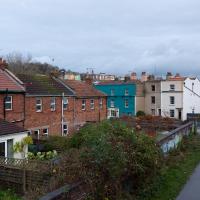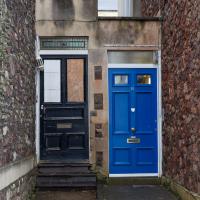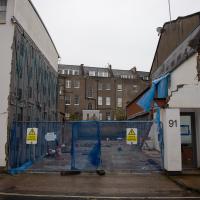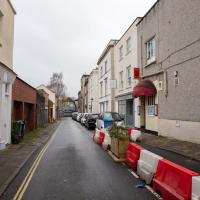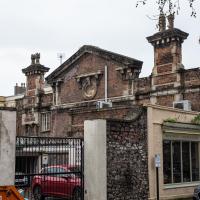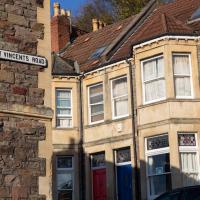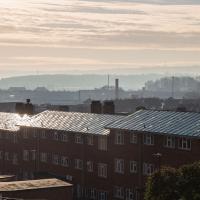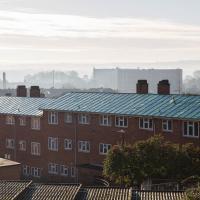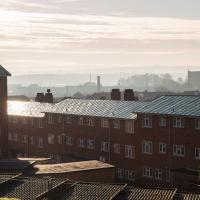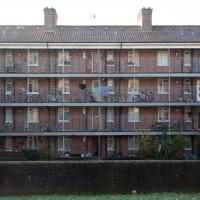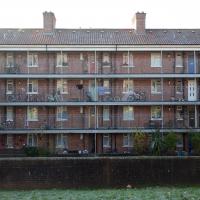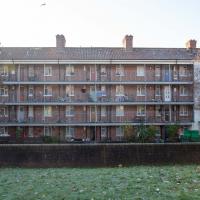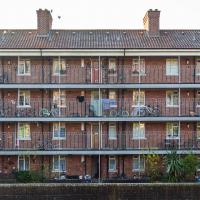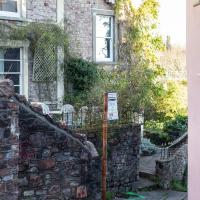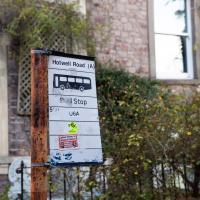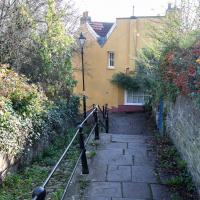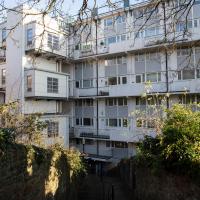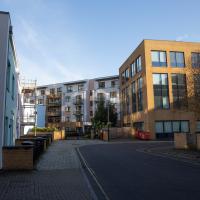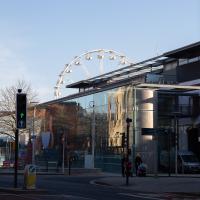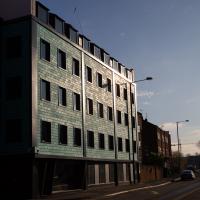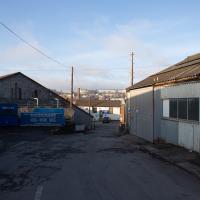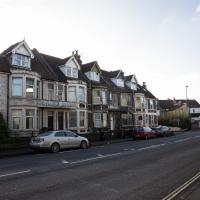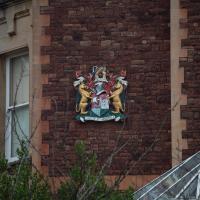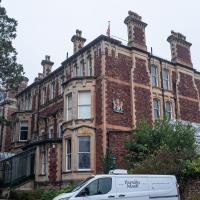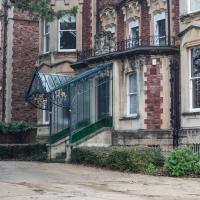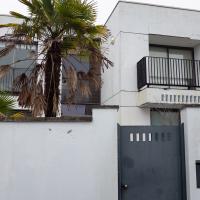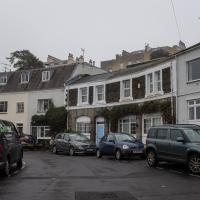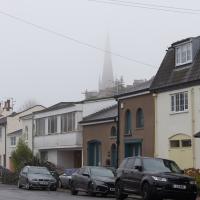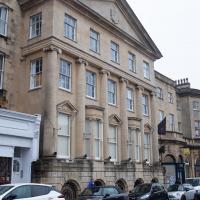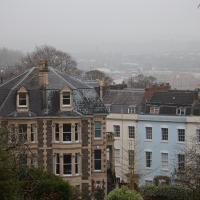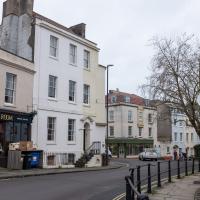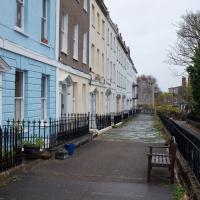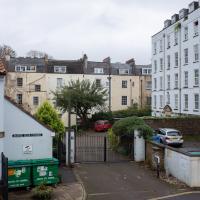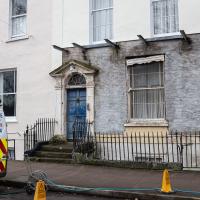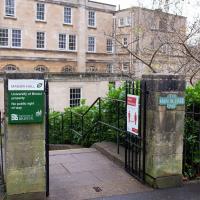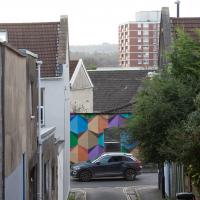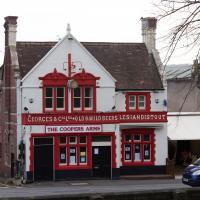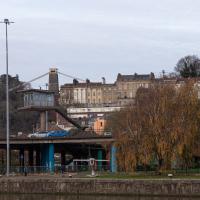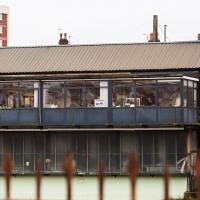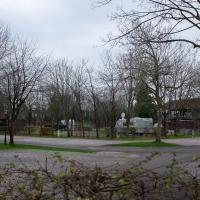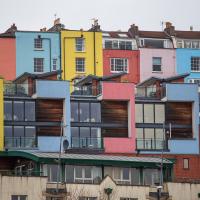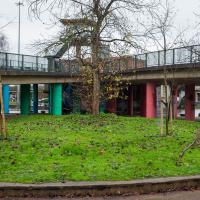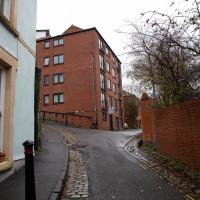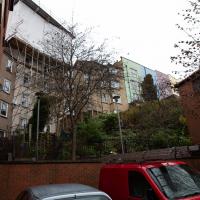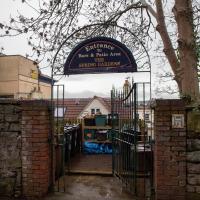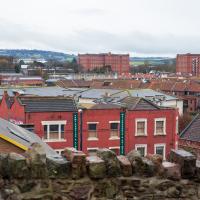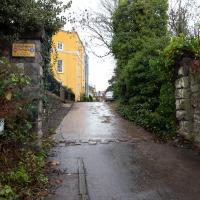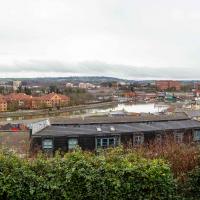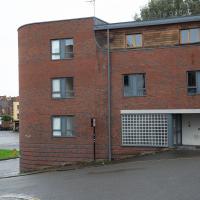Tagged: residential-area
Underpass
25 Nov 2020
A quick lunchtime jaunt for coffee. I've often wondered about the dots on the wall of the underpass. Apparently they're not intelligible Braille. Maybe it's Marain :D
I don't think I ever crossed this bridge on foot before starting my "One Mile Matt" project.
And Back Down the Hill from the Flu Jab
21 Nov 2020
This is my return from getting my annual flu jab at Christ Church, as explained in more detail in my wander up the hill.
Used to be a fairly nondescript place with offices or a home—not sure which—over a double-garage, which seems to be the standard layout on this stretch of PVS. The only thing I remember about it is the only nondescript thing: it had a big flagpole jutting out of the top floor. You can still see a St George's Cross dangling from it on Google Street View.
Up for the flu jab
21 Nov 2020
A trip up the hill to get my winter flu jab. I'm not sure I really needed it this year, what with avoiding Covid—I haven't had so much as a sniffle in more than a year—but seeing as they offered... Instead of the doctor's surgery on Pembroke Road, they'd taken over Christ Church, presumably to give more room and ventilation for the necessary social distancing at the moment. As usual, it was their typically efficient operation, and I was in and out in about three minutes.
On the way there and back I snapped as much as I could, but I wanted to be home in time for the first online Times Crossword Championship. As it turned out, I needn't have bothered, as the technology at the Times couldn't keep up with the demand from competitors, and their system just collapsed under the weight of page-views. They tried again the day after, and it collapsed just as badly. Maybe next year...
This wander is split into two parts, as I turned my tech off to go into Christ Church for my jab. The walk home can be found over here.
Avoiding the Accounts
26 Nov 2020
I took the day off my day job to do my accounts—or at least do enough bookkeeping to send them to my accountant. I hate doing the books. I woke up late, tired and with a headache and decided to bunk off for a walk around Cliftonwood, Clifton Village and Clifton instead, taking in a couple of good coffees along the way. Thanks, Foliage Café, and Twelve for the flat whites.
From what I've worked out so far, the use of St Vincent's name around so much of Bristol, especially Hotwells and Clifton, dervies from the ancient hermitage and chapel dedicated to St Vincent of Saragossa, which (possibly) was in Ghyston’s Cave, the cave in the rock face now accessible through a tunnel from the observatory, but at the time only by a perilous cliff climb (which I can only presume is what made it so appropriate for a hermitage.)
Why St Vincent of Saragossa? Anthony Adolph says:
It should be explained that the connection of Bristol with the Iberian wine trade led, in the Middle Ages, to Bristol’s importing of the cult of Lisbon’s patron saint, Vincent.
I have done very little real research on this so far, though, so don't take my word for any of it. I am not a historian, etc.
The Hillsborough Flats are a lot prettier from the back than their frontage on the Hotwell Road suggests, I think.
The Long Lunchtime at the End of the World
27 Nov 2020
I took an extra-long break at lunchtime today as I'd taken the day off my normal day-job to do the accounts for my previous side-job, which is still generating paperwork, though not much in the way of money. This took me through some undiscovered bits of Cliftonwood, including Worlds End Lane, which unexpectedly leads to White Hart Steps. That's certainly not where I expected the end of the world to lead to...
You'll have trouble getting the bus up the White Hart steps.
Edit to add: According to my friend Jess (a very reliable source of information about Cliftonwood who's quoted in this Bristol Post article about the bus stop) it was put in 15 years ago as part of the West Bristol Arts Trail...
Well, I think bits of it are, anyway. There's one along this stretch of road, and Google Maps seems to indicate that the buildings on the left might be Thomas Ware & Sons, tanners.
A long ramble, starting with trying to find the Hot Well of Hotwells and leading up the side of the Avon Gorge to the Downs and then through Clifton for coffee.
I recently learned—after seeing reference to someone being "mewed up" in EH Young's Chatterton Square (which is set in nearby Canynge Square)—that "mew" is an old word for "moult". And that hawks used to be confined in cages called "mews" when they were moulting. That's where The Kings Mews in Charing Cross first got its name; it was where the royal hawks were confined during their moulting. Later The Kings Mews was converted to stabling, and became the place where the King's carriages were kept, and the word "mews" spread from there and began a new life a word for a road full of coachhouses, or later, garages, turning as it did from a plural to a singular. So we now have the words "mew", "mews", and "mewses", each more plural than the last!
Well, this whole street does seem quite mewsey. Christ Church pops up in the background, as it often does anywhere near Clifton Village.
It's very nice in there. I will never be wealthy enough to be asked to join, which I understand it the only qualification I don't fulfill, being white, male and old. Actually, I tell a lie; in 2006 they voted to allow women to join, after only 188 years of prior existence
Ten O'Clock Shop and Can't Dance Coffee
30 Nov 2020
I had to return a faulty AirPod Pro to Apple (there's a first-world problem!) so I just took a quick trip up the hill to the nearest UPS drop-off point, The Ten O'Clock Shop, which is famously open until 11pm. Unfortunately it's a fairly cramped little place and neither of the staff were wearing masks, so I made it a very quick drop indeed and got out of there as quickly as I could.
I grabbed a quick coffee from Can't Dance, a stall that's—as of yesterday—in a tiny converted cargo container on the edge of Victoria Square; up until this week they were running from a little trike parked in the same place. Hopefully the new premises will let them see out the winter without worrying quite so much about the weather.
I tried to fit in a few extra streets from the surrounding area on my there and back, but that was basically my wander today: a quick little shopping trip.
Mint on the left, Rosemarino on the corner ahead, where the old York Cafe used to be, serving a full English for £1, back in the day.
Got your work cut out making that window look good. They were actually working around the corner.
Fruitless Coffee Excursion
01 Dec 2020
Unfortunately by the time I got to Greville Smyth Park I was already about halfway through my lunch-hour, and the queue was too long to wait to actually get a coffee. Is that a fruitless excursion? Presumably a coffee bean is technically a fruit...
This kind of vague musing was sadly overshadowed by my delay at Ashton Avenue Bridge on the way back, where someone—hopefully still a someone, rather than a body—was being stretchered up the bank of the river, presumably having just been rescued from the water. As I made my way home the long way around, avoiding the cordoned-off area at the back of the CREATE centre and its car park, I saw an ambulance haring across the Plimsoll Bridge, siren running, presumably on its way to the BRI. I'd like to think that was a good sign.
Nothing New
02 Dec 2020
This may be the very first time I've gone for a One Mile Matt wander and not actually gone down any new roads, trod any new steps. I just wanted a coffee, frankly, so I went the same old way to Imagine That in the marina and back again.
An office for one of the industrial places along Coronation Road; I think this is the back of the metal spraying yard rather than the tannery.
Cliftonwood and a Secret Garden
03 Dec 2020
I love the isolation of Cliftonwood -- the geography of it, with its solid boundary of Clifton Vale to the west and Jacob's Wells Road to the east mean that you tend not to be in Cliftonwood unless you've got a reason to be there. It's not a cut-through to anywhere, at least not from side-to-side, and you can only really exit to the south on foot.
I sense that I'd be happy living in Cliftonwood -- like my bit of Hotwells, it's a quiet little area with a sort of quirky feel to it. Plus it contributes the colourful houses that are the backdrop of about half of all Bristol postcards ever made :)
I found the "secret" garden especially interesting, just for the fact that it really does feel quite secret, despite the obvious name on the gate. I've lived a half-mile from it for twenty years and I don't think I've ever noticed it before, despite exploring the area a few times.
I did once have a beer in the garden when it was The Spring Gardens. It became La Demi Lune for a while, from what I remember, then shut down. Having just Googled it, before it was the Spring Gardens apparently it was "Durty Nelly's"!
From what I can see on Street View it's just flats now, but I can't be sure without going and having a proper look around the front. Maybe next time...
It's a great pub. Friendly, welcoming, family-run, extremely good food. Only been a few times. I hope it weathers the Covid storm.

